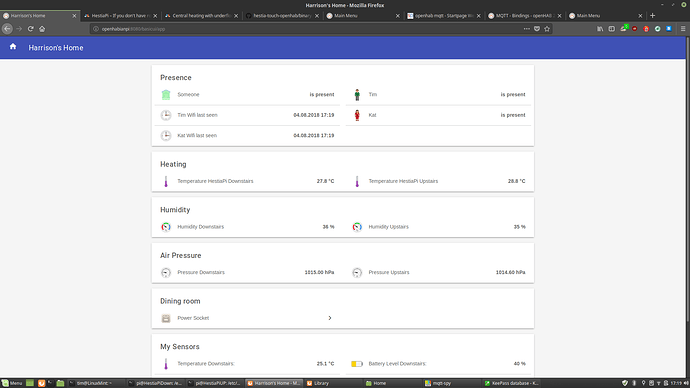@HestiaPi Ok so good news I have both thermostats up and running and I’ve made a few edits to the items and sitemaps but let me give you some feedback on what I’ve done and what I’ve noticed.
- So when I started the Pi’s for the first time at the same time I had a conflict with both Pi’s presenting the same ip address of HESTIAPI (new V10 Image with turnkey script ) which meant one I couldn’t work out immediately which Pi I was providing WIFI credentials too, but ultimately the other Pi rebooted till I managed to find its HESTIAPI network and add WIFI credentials to it . This is no major problem only what I found and obviously its only an issue should you have more than one HestiaPI.
2)I had a slight problem that I managed to mis-align an LCD display due to how it was positioned in the case and because I didn’t notice for about 10 minutes this somehow was short circuiting and cause the transformer to heat up to the point where you couldn’t touch it. Once I realised what I had done, rectified and restarted the Pi it cooled down. I thought I would mention this to help out anyone that might make this mistake, make sure that the connection block on the back of the LCD is perfectly in line with the PI GPios and make sure the LCD illuminates before moving on .
3)Ok so I have a few errors in the openhab log, I was wondering if you could shed some light on .
these are the errors I see often,
Validation issues found in configuration model 'default.rules', using it anyway:
The operator '!=' should be replaced by '!==' when null is one of the arguments.
2018-08-04 11:56:55.665 [WARN ] [.core.transform.TransformationHelper] - Cannot get service reference for transformation service of type MAP
2018-08-04 11:56:55.739 [WARN ] [b.core.events.EventPublisherDelegate] - given new state is NULL, couldn't post update for 'HeatingPin23'
2018-08-04 14:46:15.275 [ERROR] [ntime.internal.engine.RuleEngineImpl] - Rule 'Heating Mode': An error occurred during the script execution: Could not invoke method: org.eclipse.smarthome.model.script.actions.BusEvent.sendCommand(org.eclipse.smarthome.core.items.Item,java.lang.String) on instance: null
2018-08-04 12:18:11.546 [ERROR] [ntime.internal.engine.RuleEngineImpl] - Rule 'convertproxy': The name 'MyTempProxy' cannot be resolved to an item or type; line 48, column 3, length 11
now I did notice that the transform for the binary.map for the heating switch item was not present in the transform directory of the new image . I don’t know if there is a reason for this but I added the transform from the github pages .
- why do I receive this image when I boot the Pi ? is it something to do with the other HestiaPi or is it because the initial hostname on my router for that IP was Raspberry pi and now its HestiaPiUp /Down this wont change until the address lease runs out on the router if that makes any sense, any ideas ?
and finally I could do with some advice. I’m working with the Mqtt and as we discussed I changed the client name for each HestiaPi in the mqtt.cfg file but I couldn’t subscribe to a client id so I had to modify the items themselves to
<[mosquitto:hestiadownstairs/local/settempsetpoint:state:default]"}
for example .
and now I have the items showing on my existing sytem .
my question is if I want to control the set point I will need to raise or lower the temp with switches like in the main menu (basic Ui) of the hestiaPi’s
as I understand it the switches change the target temp with rules, will I need to add these rules to my existing openhab to raise and lower the target temp ?
I have been successful in using Mqttspy to publish a temp to the HestiaPi on the topic I know its listening to but to increase and decrease incrementally using switches requires rules, right?
I also have a question regarding the Habpanel. How do I remove certain elements that are displayed ? I mean I don’t need the hot water boost or control to be displayed just Heating and the settings menu.
Thanks for all your efforts I cant believe I’ve made it this far and now can control my heating upstairs and downstairs using the Pi’s or my laptop



 )
)





